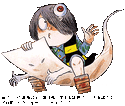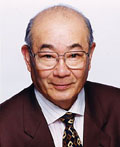No edit summary |
(→About) |
||
| Line 14: | Line 14: | ||
The second anime was aired from October 7, 1971 to September 28, 1972. It ran for 45 episodes. Produced only two years after the [http://gegegenokitaro.wikia.com/wiki/GeGeGe_no_Kitar%C5%8D_(1968) first series] and featuring the same main voice cast and theme songs, it is sometimes considered a colorized sequel to the first rather than a second entry in the series. Like the previous series, it was produced by [[Toei Animation]] and boradcast on [[Fuji Television]]. |
The second anime was aired from October 7, 1971 to September 28, 1972. It ran for 45 episodes. Produced only two years after the [http://gegegenokitaro.wikia.com/wiki/GeGeGe_no_Kitar%C5%8D_(1968) first series] and featuring the same main voice cast and theme songs, it is sometimes considered a colorized sequel to the first rather than a second entry in the series. Like the previous series, it was produced by [[Toei Animation]] and boradcast on [[Fuji Television]]. |
||
==About== |
==About== |
||
| − | Because the 1971 anime is a sequel to the previous anime, no remake episodes were made. Because of this, nearly half of the episodes are actually adaptations of some of [[Shigeru Mizuki]]'s non-Kitarō stories. In the previous anime, this was only done twice towards the end of the run, with the episodes ''[[ |
+ | Because the 1971 anime is a sequel to the previous anime, no remake episodes were made. Because of this, nearly half of the episodes are actually adaptations of some of [[Shigeru Mizuki]]'s non-Kitarō stories. In the previous anime, this was only done twice towards the end of the run, with the episodes ''[[Series 1 Episode 62|Umi-Jijii]]'' and ''[[Series 1 Episode 63|Namahage]]''. Many of these stories were originally self contained and ironic, leaving little room for [[Kitarō]] to intervene. Some of these episodes featured Kitarō briefly and sometimes without him actually getting involved, deviating from the general "children's hero" theme of the rest of the series. On the other hand, because much more of the social satire and horror was left in this time around, it could be considered a more faithful adaptation of the essence of Mizuki's work. Of all the ''GeGeGe no Kitarō'' anime, this was the one to feature the most social commentary and irony. |
Another factor in this series being more mature and dramatic is that most of the Toei staff that worked on it was transferred from the recently completed ''[[wikipedia:Tiger Mask|Tiger Mask]]''. |
Another factor in this series being more mature and dramatic is that most of the Toei staff that worked on it was transferred from the recently completed ''[[wikipedia:Tiger Mask|Tiger Mask]]''. |
||
| Line 20: | Line 20: | ||
Unlike the previous anime, which was rarely rebroadcast, the 1971 anime was rebroadcast several times in the following years, usually during the summer. |
Unlike the previous anime, which was rarely rebroadcast, the 1971 anime was rebroadcast several times in the following years, usually during the summer. |
||
| − | While 45 episodes were produced, the original broadcast had a full 52 episode run thanks to many episode being aired as reruns. These episodes were ''[[Yōkai |
+ | While 45 episodes were produced, the original broadcast had a full 52 episode run thanks to many episode being aired as reruns. These episodes were ''[[Series 2 Episode 2|Yōkai Cloth]]'' (rebroadcast March 16, 1972), ''[[Series 2 Episode 6|Shibito-Tsuki]]'' (May 18, 1972), ''[[Series 2 Episode 10|Ghosts of Angkor Wat]]'' (June 8, 1972), ''[[Series 2 Episode 15|Gyūki]]'' (July 6, 1972), ''[[Series 2 Episode 23|Gyaku-Mochi-Goroshi]]'' (August 3, 1972), ''[[Series 2 Episode 8|Mammoth Flower]]'' (August 31, 1972), and ''[[Series 2 Episode 22|Hell's Water]]'' (September 14, 1972). |
| + | |||
| ⚫ | |||
| ⚫ | |||
==Theme Songs== |
==Theme Songs== |
||
;Opening |
;Opening |
||
Revision as of 06:44, 10 October 2018

|
This article is a stub. You can help the GeGeGe no Kitarō Wiki by expanding it. |
The second anime was aired from October 7, 1971 to September 28, 1972. It ran for 45 episodes. Produced only two years after the first series and featuring the same main voice cast and theme songs, it is sometimes considered a colorized sequel to the first rather than a second entry in the series. Like the previous series, it was produced by Toei Animation and boradcast on Fuji Television.
About
Because the 1971 anime is a sequel to the previous anime, no remake episodes were made. Because of this, nearly half of the episodes are actually adaptations of some of Shigeru Mizuki's non-Kitarō stories. In the previous anime, this was only done twice towards the end of the run, with the episodes Umi-Jijii and Namahage. Many of these stories were originally self contained and ironic, leaving little room for Kitarō to intervene. Some of these episodes featured Kitarō briefly and sometimes without him actually getting involved, deviating from the general "children's hero" theme of the rest of the series. On the other hand, because much more of the social satire and horror was left in this time around, it could be considered a more faithful adaptation of the essence of Mizuki's work. Of all the GeGeGe no Kitarō anime, this was the one to feature the most social commentary and irony.
Another factor in this series being more mature and dramatic is that most of the Toei staff that worked on it was transferred from the recently completed Tiger Mask.
Unlike the previous anime, which was rarely rebroadcast, the 1971 anime was rebroadcast several times in the following years, usually during the summer.
While 45 episodes were produced, the original broadcast had a full 52 episode run thanks to many episode being aired as reruns. These episodes were Yōkai Cloth (rebroadcast March 16, 1972), Shibito-Tsuki (May 18, 1972), Ghosts of Angkor Wat (June 8, 1972), Gyūki (July 6, 1972), Gyaku-Mochi-Goroshi (August 3, 1972), Mammoth Flower (August 31, 1972), and Hell's Water (September 14, 1972).
In episode #4, Amefuri-Tengu, Medama-Oyaji's regular voice actor Isamu Tanonaka was sick and the role was performed by Hiroshi Ōtake. This was one of only two times in Tanonaka's lifetime where he didn't voice the character.
Theme Songs
- Opening
- Ending
Episodes
| # | Title | Original airdate | Written by | Directed by | Animation director | Yōkai |
| 01 | Return of the Yōkai Yōkai Fukkatsu (妖怪復活) |
1971-10-07 | {{{6}}} | {{{7}}} | {{{8}}} | Dorotabō |
|---|---|---|---|---|---|---|
| 02 | Yōkai Cloth Yōkai Tanmono (妖怪反物) |
1971-10-14 | {{{6}}} | {{{7}}} | {{{8}}} | Chi |
|---|---|---|---|---|---|---|
| 03 | The Great Yōkai Trial Yōkai Dai-Saiban (妖怪大裁判) |
1971-10-21 | {{{6}}} | {{{7}}} | {{{8}}} | Momon-Jii |
|---|---|---|---|---|---|---|
| 04 | Amefuri-Tengu Amefuri-Tengu (雨ふり天狗) |
1971-10-28 | {{{6}}} | {{{7}}} | {{{8}}} | Amefuri-Tengu |
|---|---|---|---|---|---|---|
| 05 | Ashi-Magari Ashi-Magari (あしまがり) |
1971-11-04 | {{{6}}} | {{{7}}} | {{{8}}} | Ashi-Magari |
|---|---|---|---|---|---|---|
| 06 | Shibito-Tsuki Shibito-Tsuki (死人つき) |
1971-11-11 | {{{6}}} | {{{7}}} | {{{8}}} | Mōryō |
|---|---|---|---|---|---|---|
| 07 | Neko-Mata Neko-Mata (猫又) |
1971-11-18 | {{{6}}} | {{{7}}} | {{{8}}} | Neko-Mata Kitsune |
|---|---|---|---|---|---|---|
| 08 | Mammoth Flower Manmosu Furawā (マンモスフラワー) |
1971-11-25 | {{{6}}} | {{{7}}} | {{{8}}} | Mammoth Flower Akaname |
|---|---|---|---|---|---|---|
| 09 | Kami-sama Kami-sama (髪さま) |
1971-12-02 | {{{6}}} | {{{7}}} | {{{8}}} | Kami-sama Kemedama |
|---|---|---|---|---|---|---|
| 10 | Ghosts of Angkor Wat Ankōru Watto no Bōrei (アンコールワットの亡霊) |
1971-12-09 | {{{6}}} | {{{7}}} | {{{8}}} | Ghosts |
|---|---|---|---|---|---|---|
| 11 | Tsuchi-Korobi Tsuchi-Korobi (土ころび) |
1971-12-16 | {{{6}}} | {{{7}}} | {{{8}}} | Tsuchi-Korobi |
|---|---|---|---|---|---|---|
| 12 | Yamata-no-Orochi Yamata-no-Orochi (やまたのおろち) |
1971-12-23 | {{{6}}} | {{{7}}} | {{{8}}} | Yamata-no-Orochi Yobuko |
|---|---|---|---|---|---|---|
| 13 | Kamaboko Kamaboko (かまぼこ) |
1971-12-30 | {{{6}}} | {{{7}}} | {{{8}}} | Han-Gyojin Giant Squid |
|---|---|---|---|---|---|---|
| 14 | Suspicious Car Kai Jidōsha (怪自動車) |
1972-01-06 | {{{6}}} | {{{7}}} | {{{8}}} | Yōkai Car Sunekosuri |
|---|---|---|---|---|---|---|
| 15 | Gyūki Gyūki (牛鬼) |
1972-01-13 | {{{6}}} | {{{7}}} | {{{8}}} | Gyūki |
|---|---|---|---|---|---|---|
| 16 | Invitation from the South Minami kara no Maneki (南からの招き) |
1972-01-20 | {{{6}}} | {{{7}}} | {{{8}}} | Frogman |
|---|---|---|---|---|---|---|
| 17 | Divorce Insects Enkiri-Mushi (縁切り虫) |
1972-01-27 | {{{6}}} | {{{7}}} | {{{8}}} | Enriki-Mushi |
|---|---|---|---|---|---|---|
| 18 | A Monster Named Happiness Kōfuku toiu Na no Kaibutsu (幸福という名の怪物) |
1972-02-03 | {{{6}}} | {{{7}}} | {{{8}}} | Jigoku-Dama |
|---|---|---|---|---|---|---|
| 19 | Kamanari Kamanari (釜鳴り) |
1972-02-10 | {{{6}}} | {{{7}}} | {{{8}}} | Kamanari |
|---|---|---|---|---|---|---|
| 20 | Fukuro-Sage Fukuro-Sage (ふくろさげ) |
1972-02-17 | {{{6}}} | {{{7}}} | {{{8}}} | Fukuro-Sage |
|---|---|---|---|---|---|---|
| 21 | Worry Shop Shinpai-ya (心配屋) |
1972-02-24 | {{{6}}} | {{{7}}} | {{{8}}} | Bari-Bari |
|---|---|---|---|---|---|---|
| 22 | Hell's Water Jigoku no Mizu (地獄の水) |
1972-03-02 | {{{6}}} | {{{7}}} | {{{8}}} | Mizugami |
|---|---|---|---|---|---|---|
| 23 | Gyaku-Mochi-Goroshi Gyaku-Mochi-Goroshi (逆餅殺し) |
1972-03-09 | {{{6}}} | {{{7}}} | {{{8}}} | Kasha |
|---|---|---|---|---|---|---|
| 24 | Kasa-Bake Kasa-Bake (傘ばけ) |
1972-03-23 | {{{6}}} | {{{7}}} | {{{8}}} | Kasa-Bake |
|---|---|---|---|---|---|---|
| 25 | The Phantom Train Maboroshi no Kisha (まぼろしの汽車) |
1972-03-30 | {{{6}}} | {{{7}}} | {{{8}}} | Pii Monroe |
|---|---|---|---|---|---|---|
| 26 | Ōkubi Ōkubi (大首) |
1972-04-06 | {{{6}}} | {{{7}}} | {{{8}}} | Ōkubi Hone-Onna |
|---|---|---|---|---|---|---|
| 27 | Iyami Iyami (いやみ) |
1972-04-13 | {{{6}}} | {{{7}}} | {{{8}}} | Iyami |
|---|---|---|---|---|---|---|
| 28 | Akaname Akaname (あかなめ) |
1972-04-20 | {{{6}}} | {{{7}}} | {{{8}}} | Akaname |
|---|---|---|---|---|---|---|
| 29 | Daidarabotchi Daidarabotchi (ダイダラボッチ) |
1972-04-27 | {{{6}}} | {{{7}}} | {{{8}}} | Daidarabotchi |
|---|---|---|---|---|---|---|
| 30 | Shinigami Shinigami (死神) |
1972-05-04 | {{{6}}} | {{{7}}} | {{{8}}} | Shinigami Witch |
|---|---|---|---|---|---|---|
| 31 | Akashita Akashita (赤舌) |
1972-05-11 | {{{6}}} | {{{7}}} | {{{8}}} | Akashita Hone-Onna |
|---|---|---|---|---|---|---|
| 32 | Mokumokuren Mokumokuren (目目連) |
1972-05-25 | {{{6}}} | {{{7}}} | {{{8}}} | Mokumokuren |
|---|---|---|---|---|---|---|
| 33 | Akuma Buer Akuma Bueru (悪魔ブエル) |
1972-06-01 | {{{6}}} | {{{7}}} | {{{8}}} | Buer Yakanzuru |
|---|---|---|---|---|---|---|
| 34 | Shinigami and Satori Shinigami to Satori (死神とサトリ) |
1972-06-15 | {{{6}}} | {{{7}}} | {{{8}}} | Shinigami Satori |
|---|---|---|---|---|---|---|
| 35 | Easter Island Epitaph Īsutā-tō Kidan (イースター島奇談) |
1972-06-22 | {{{6}}} | {{{7}}} | {{{8}}} | Aku-Aku |
|---|---|---|---|---|---|---|
| 36 | Yōkai Mansion Yōkai Yashiki (妖怪屋敷) |
1972-06-29 | {{{6}}} | {{{7}}} | {{{8}}} | Kage-Onna |
|---|---|---|---|---|---|---|
| 37 | Chisōgan Chisōgan (地相眼) |
1972-07-13 | {{{6}}} | {{{7}}} | {{{8}}} | Giant Mice others |
|---|---|---|---|---|---|---|
| 38 | Hidden Village of Shinigami Kakurezato no Shinigami (隠れ里の死神) |
1972-07-20 | {{{6}}} | {{{7}}} | {{{8}}} | Shinigami Kakure-Zatō |
|---|---|---|---|---|---|---|
| 39 | Yōkai Waterwheel Yōkai Suisha (妖怪水車) |
1972-07-27 | {{{6}}} | {{{7}}} | {{{8}}} | Mōrei-Yassan |
|---|---|---|---|---|---|---|
| 40 | Genshi-san Genshi-san (原始さん) |
1972-08-10 | {{{6}}} | {{{7}}} | {{{8}}} | Genshi-san |
|---|---|---|---|---|---|---|
| 41 | Spirit Surgery Reikei Shujutsu (霊形手術) |
1972-08-17 | {{{6}}} | {{{7}}} | {{{8}}} | Zunbera |
|---|---|---|---|---|---|---|
| 42 | Shinigami and Binbōgami Shinigami to Binbōgami (死神と貧乏神) |
1972-08-24 | {{{6}}} | {{{7}}} | {{{8}}} | Shinigami Binbōgami |
|---|---|---|---|---|---|---|
| 43 | Suspicious Footprints Ashiato no Kai (足跡の怪) |
1972-09-07 | {{{6}}} | {{{7}}} | {{{8}}} | Taitanbō |
|---|---|---|---|---|---|---|
| 44 | Amagami Yumuchakku Amagami Yumuchakku (雨神 ユムチャック) |
1972-09-21 | {{{6}}} | {{{7}}} | {{{8}}} | Yumuchakku |
|---|---|---|---|---|---|---|
| 45 | Shinigami's Quota Shinigami no Noruma (死神の ノルマ) |
1972-09-28 | {{{6}}} | {{{7}}} | {{{8}}} | Shinigami Pasha |
|---|---|---|---|---|---|---|
Cast
| Main Cast | |||
|---|---|---|---|

|

|

|

|
| Masako Nozawa as Kitarō |
Isamu Tanonaka as Medama-Oyaji |
Chikao Ōtsuka as Nezumi-Otoko |
Yōko Ogushi as Neko-Musume |
| Recurring Cast | ||
|---|---|---|

|

|

|
| Keiko Yamamoto as Sunakake-Babaa |
Takuzō Kamiyama as Shinigami |
Kōji Yada as Konaki-Jijii |
Guest Cast
- Shōji Aoki
- Junji Chiba
- Sachiko Chijimatsu
- Sanji Hase
- Michiko Hirai
- Masao Imanishi - Akaname, Daidarabotchi, Genji-san
- Shingo Kanemoto - Konaki-Jijii (Ep. 21), Han-Gyojin, Kasa-Bake and others
- Osamu Katō - Amimoto
- Reiko Katsura
- Yonehiko Kitagawa
- Haruko Kitahama - Kage-Onna
- Takako Kondō - Monroe
- Hiroshi Masuoka
- Kōhei Miyauchi - Binbōgami
- Katsuji Mori
- Shūichirō Moriyama - Bael
- Ichirō Nagai
- Taeko Nakanishi - Hone-Onna and others
- Rokurō Naya
- Keita Nishi
- Keiichi Noda - Maruge and others
- Michiko Nomura
- Toshiaki Okamoto
- Noriko Ohara
- Hiroshi Ōtake
- Ryūji Saikachi - Satori
- Hidekatsu Shibata
- Sumiko Shirakawa
- Kazuko Sugiyama
- Taimei Suzuki - Pii, Pasha
- Ryōichi Tanaka
- Kazuya Tatekabe - Zunbera
- Kōsei Tomita
- Akiko Tsuboi
- Noriko Watanabe
- Keaton Yamada - Ittan-Momen, Amefuri-Kozō and others
- Nana Yamaguchi
- Jōji Yanami
- Rihoko Yoshida
Staff
Movies
- Gegege no Kitarō: Chisougan - Released July 12, 1980. A retelling of Episode 37.
